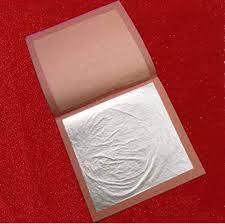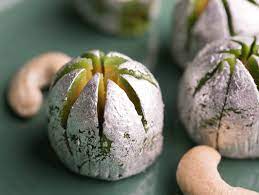
Science Project On How Silver Foil On Sweets Is Made For Class 9th
Introduction
Silver foil, often referred to as “Varak” or “Vark” across diverse cultures, embodies the essence of delicate opulence, adorning confections with an unrivaled grace. This wafer-thin sheet of pure silver carries a legacy of luxury and tradition that has endured for centuries, with its roots deeply embedded in the cultural tapestry of India. The craft of fashioning silver foil has gracefully traversed the sands of time, merging time-honored craftsmanship with contemporary techniques. In this all-encompassing odyssey, we embark on an enchanting expedition into the captivating realm of silver foil production, unraveling its historical lineage and immersing ourselves in its present-day significance within the culinary landscape.

Objective
The central aim of this endeavor is to bestow upon you a profound understanding of the intricate alchemy that births silver foil while accentuating its pivotal role in the gastronomic domain. We shall traverse the annals of time to fathom the genesis of this art, its cultural reverberations, and the cutting-edge methodologies that breathe life into this ethereal embellishment. As we conclude this journey, you shall emerge with a holistic appreciation for the artistry and science underpinning silver foil, recognizing its pivotal contribution in elevating the visual and gustatory delight of diverse culinary creations.
Materials
Silver Source:
The journey of crafting silver foil commences with the selection of high-purity silver, typically boasting an impressive 99.9% purity. Traditional artisans might opt for silver coins, while modern methods often favor the use of silver bars.
Traditional Beating Process:
Edible Paper Preparation:
Edible paper, known as “Vark paper,” is artfully fashioned from the delicate intestines of cows or goats, ensuring a harmonious union of silver and sustenance.
Layering Silver and Paper:
A meticulous process unfolds as a sheet of pristine silver is tenderly nestled between multiple layers of edible paper, creating a fusion of elegance and palatability.
Manual Beating:
The pivotal moment arrives when skilled artisans step in, carefully placing the silver-paper ensemble between two wooden blocks. With a mallet in hand, they embark on a rhythmic dance of precision and expertise, manually beating the stack. This step is the crucible where mastery meets artistry.

Modern Rolling Process:
Silver Melting and Casting:
In the realm of modern production, silver metamorphoses from its solid state into a molten cauldron, only to be cast into a thin, ethereal sheet.
Rolling Out:
The cast silver sheet embarks on a transformative journey, navigating rolling machines adorned with precision rollers. Here, its thickness is deftly controlled and calibrated to achieve the desired gossamer thinness, a testament to human ingenuity and engineering finesse.
Cutting and Packaging:
Cutting Silver Foil:
The resulting tapestry of silver is meticulously carved into petite squares or rectangles, each a jewel in its own right.
Preservation:
To safeguard its shimmering allure and preserve its untarnished splendor, the silver foil is ushered into a controlled sanctuary. Here, it often finds solace sandwiched between sheets of tissue paper or ensconced within hermetic containers, a shrine to its timeless elegance.
Application on Sweets:
Adornment Process:
The crowning moment for silver foil arrives as it bestows its resplendent touch upon an array of confections, spanning the realm of Indian desserts, chocolates, and the revered paan. With reverence and finesse, a delicate fragment of silver foil graces the surface of these creations.
Delicate Pressing:
Guided by the hands of skilled artisans or culinary maestros, the silver foil is gently pressed onto the sweet’s canvas, an act of artistry that seamlessly integrates elegance without altering the taste or texture. This delicate embrace ensures that the foil serves as a visual ode to indulgence, an adornment that transcends the mundane and elevates the sensory journey of each sweet morsel.
Significance
The Luminous Symbolism of Silver Foil:
Silver foil, a delicate and radiant embellishment, transcends its visual allure to become a multifaceted symbol deeply etched into the fabric of various cultures and culinary traditions. Its significance spans beyond the realms of aesthetics, encompassing cultural, religious, and even health-related dimensions.
Aesthetic Marvel:
In the world of culinary craftsmanship, silver foil emerges as a beacon of opulence, casting its shimmering brilliance upon sweets, chocolates, and other delectable creations. Its lustrous sheen does more than tantalize the taste buds; it transforms these delicacies into visually captivating works of art.
Cultural and Spiritual Embrace:
Across numerous communities, notably in the heart of India and various Asian cultures, silver foil carries profound cultural and religious resonance. This ethereal adornment symbolizes purity, serving as a vessel of sanctity and divinity. When it graces culinary creations, it elevates the act of nourishment into a spiritual and ceremonial experience.
Festive Reverence:
During moments of jubilation and devotion, silver foil takes center stage as a common embellishment during auspicious occasions, religious rituals, and festivals. It weaves its luminous threads into the fabric of celebration and reverence, adorning sweets and offerings in homage to the joyous occasion. Festivals like Diwali, weddings, and sacred rites find their significance enhanced by the presence of silver foil.
Healthful Whispers:
While not the primary rationale for its culinary use, silver possesses remarkable antimicrobial properties that resonate with health-conscious individuals. Incorporating trace amounts of edible silver is generally considered safe for most, adding a subtle layer of food safety to culinary delights. The caveat lies in the choice of food-grade silver and adherence to recommended usage, ensuring that health and indulgence gracefully coexist.
Conclusion
The craft of crafting silver foil for sweets represents a captivating fusion of age-old traditions and cutting-edge technological advancements. Whether born from the painstaking manual beating process or the precision-driven modern rolling method, this delicate embellishment transcends its culinary role. It weaves a tapestry of cultural and religious significance that stretches across generations.
The essence of silver foil goes far beyond its visual charm. It stands as a beacon of purity and elegance, an embodiment of sanctity and divinity in numerous communities, notably India and various Asian cultures. Its presence during auspicious occasions, festivals, and religious ceremonies elevates the spiritual essence of the culinary offerings it graces.
Moreover, silver foil’s position in the culinary realm acts as a testament to the richness and diversity of global culinary traditions. Its application on sweets and desserts exemplifies how food transforms into a canvas for cultural expression and heritage preservation, transcending mere sustenance.
As we delve deeper into the art and science of silver foil production, we unearth profound insights into the intricate interplay between food and culture. It underscores the profound idea that food, beyond its nourishing properties, carries the weight of tradition, symbolizes unity in diversity, and weaves the fabric of our shared heritage.
In conclusion, our expedition through the process and significance of silver foil on sweets bestows upon us a profound appreciation for the culinary wonders that enrich our lives. It serves as a reminder that even the most humble of adornments can carry the weight of centuries-old traditions. In the world of cuisine, every dish becomes a masterpiece of cultural heritage, and each bite is a celebration of our shared human history.
Reference
- Encyclopaedia Britannica. (n.d.). Varak. https://www.britannica.com/topic/varak
- Food Safety and Standards Authority of India. (2011). Report of the Scientific Panel on Food Additives, Flavourings, Processing Aids and Materials in Contact with Food (Cereals & Cereal Products Including Bakery & Confectionary Items). https://www.fssai.gov.in/upload/uploadfiles/files/Final_Report_Silver_Leaf_21_02_2017.pdf
Certificate of Completion
[Student’s Name][Class/Grade Level]This is to certify that I, [Student’s Name], a [Class/Grade Level] student, have successfully completed the project on “How Silver Foil On Sweets Is Made For Class 9th.” The project explores the fundamental principles and key aspects of the chosen topic, providing a comprehensive understanding of its significance and implications.
In this project, I delved into in-depth research and analysis, investigating various facets and relevant theories related to the chosen topic. I demonstrated dedication, diligence, and a high level of sincerity throughout the project’s completion.
Key Achievements:
Thoroughly researched and analyzed Science Project On How Silver Foil On Sweets Is Made For Class 9th.
Examined the historical background and evolution of the subject matter.
Explored the contributions of notable figures in the field.
Investigated the key theories and principles associated with the topic.
Discussed practical applications and real-world implications.
Considered critical viewpoints and alternative theories, fostering a well-rounded understanding.
This project has significantly enhanced my knowledge and critical thinking skills in the chosen field of study. It reflects my commitment to academic excellence and the pursuit of knowledge.
Date: [Date of Completion]Signature: [Your Signature] [School/Institution Name][Teacher’s/Examiner’s Name and Signature]
In order to download the PDF, You must follow on Youtube. Once done, Click on Submit
Follow On YoutubeSubscribed? Click on Confirm
Download Science Project On How Silver Foil On Sweets Is Made For Class 9th PDF






